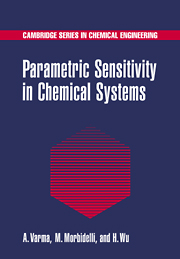Book contents
- Frontmatter
- Contents
- Preface
- 1 Introduction
- 2 Introduction to Sensitivity Analysis
- 3 Thermal Explosion in Batch Reactors
- 4 Runaway in Tubular Reactors
- 5 Parametric Sensitivity in Continuous-Flow Stirred Tank Reactors
- 6 Runaway in Fixed-Bed Catalytic Reactors
- 7 Parametric Sensitivity and Ignition Phenomena in Combustion Systems
- 8 Sensitivity Analysis in Mechanistic Study and Model Reduction
- 9 Sensitivity Analysis in Air Pollution
- 10 Sensitivity Analysis in Metabolic Processes
- Author Index
- Subject Index
3 - Thermal Explosion in Batch Reactors
Published online by Cambridge University Press: 04 May 2010
- Frontmatter
- Contents
- Preface
- 1 Introduction
- 2 Introduction to Sensitivity Analysis
- 3 Thermal Explosion in Batch Reactors
- 4 Runaway in Tubular Reactors
- 5 Parametric Sensitivity in Continuous-Flow Stirred Tank Reactors
- 6 Runaway in Fixed-Bed Catalytic Reactors
- 7 Parametric Sensitivity and Ignition Phenomena in Combustion Systems
- 8 Sensitivity Analysis in Mechanistic Study and Model Reduction
- 9 Sensitivity Analysis in Air Pollution
- 10 Sensitivity Analysis in Metabolic Processes
- Author Index
- Subject Index
Summary
A well-stirred batch reactor is characterized by the system variables (temperature and concentrations) varying with time and an (approximately) constant volume. Runaway or explosion may occur in a batch reactor, following two main mechanisms. In the first one, the rate of heat generation is faster than the rate of heat removal by the cooling system, thus leading to a continuous rise in the reactor temperature with a consequent acceleration of the reactions, leading eventually to explosion. The second mechanism involves chain branching processes, i.e., reactions that produce two or more active species from a single one, which again under certain conditions may accelerate the chemical reactions leading to an explosion. The former is generally referred to as thermal explosion or thermal runaway, and the latter as chain branching-induced explosion. Obviously, chain branching-induced explosion can occur only in a complex reacting system, where several elementary reaction steps are involved, as is typically the case in combustion processes.
The explosion phenomena encountered in the decomposition of azomethane (Allen and Rice, 1935) and methyl nitrate vapor (Apin et al, 1936; Gray et al, 1981), and the catalytic hydrolysis of acetic anhydride (Haldar and Rao, 1992), which will be examined in detail in later sections, are mainly characterized by thermal processes. A good example for the pure chain branching-induced explosion is the reaction of stoichiometric oxygen-hydrogen mixtures at very low pressure (a few Torr).
- Type
- Chapter
- Information
- Parametric Sensitivity in Chemical Systems , pp. 36 - 79Publisher: Cambridge University PressPrint publication year: 1999
- 1
- Cited by



